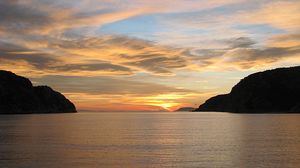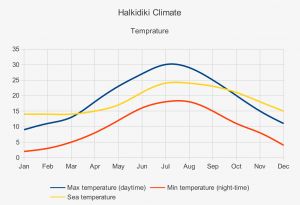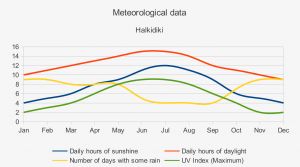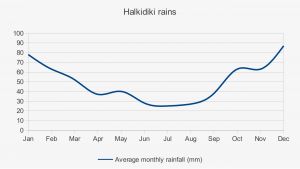
Halkidiki Weather
Weather in Halkidiki and the Climate of Chalkidiki in 2025
Halkidiki is one of the 7 areas of Central Macedonia of Greece. It has 2 large mountains Holomontas in the north and Mount Athos to the southeast. With the exception of the North, it is surrounded by the sea and has 3 large peninsulas Kassandra, Sithonia, and Athos. Halkidiki weather and climate have large differences between the mountainous north and the seaside south that create a lot of micro-climate areas. These micro-climate areas are subject mostly to altitude and distance from the coast. Generally, winter has moderate low temperatures with moderate rains and snowfalls (in the mountainous centre north) from Late November to early April. Summer is warm with a few showers. The climate in Halkidiki is very different than the Northern closest larger city of Thessaloniki weather.
April weather in Halkidiki
Halkidiki weather in May
Halkidiki climate in June
Halkidiki’s hot temperatures and weather in July
Halkidiki in August is a hot month
Halkidiki weather in September
Is Halkidiki weather in October good for travel?
Halkidiki weather temperatures all year from January to December
 At the beginning of winter a combination of high pressure in the Balkans with low pressure in West Aegean and later South Aegean, The result of these conditions is substantial rain or snow depending on temperatures. North winds especially north-west affect mostly the West coast and West Kassandra and much less the west coast of the other two peninsulas. Waves at the west are substantial but less between the peninsulas.
At the beginning of winter a combination of high pressure in the Balkans with low pressure in West Aegean and later South Aegean, The result of these conditions is substantial rain or snow depending on temperatures. North winds especially north-west affect mostly the West coast and West Kassandra and much less the west coast of the other two peninsulas. Waves at the west are substantial but less between the peninsulas.
While the winter is progressing and at the beginning of the spring the barometric combinations are replaced by cold air masses moving from the northeast, rains, and snow are far less and Eastside is greatly affected. Waves on the east side of Mount Athos and the Southeast of Sithonia are substantial.
Between the peninsulas, in the North, the waves of the bay are not really a problem.
In the spring cold air mass invasions gradually stop and when we have low pressure in the Aegean Southerlies affect almost all of Halkidiki’s coastline. The waves are much larger than the actual wind. Rains are much less and gradually the first thermal clouds start to appear over mountain mass.
While Spring is progressing the weather is generally excellent and a sea breeze starts to appear mainly in the afternoon hours. This sea breeze is a local wind and depends on the characteristics of each area. Some general properties are:
 its maximum is in the midday-early afternoon
its maximum is in the midday-early afternoon- it stops with the sunset
- when it starts its vertical to the shore and then turns towards the direction of the sun.
- when we see the first thermal clouds over the mountains it’s an indication a sea breeze is coming.
- Depending on the area it usually can be felt up to 3 miles from the shore.
The wind during the Spring is weak, and near the shoreline, a breeze is happening almost every day, while over land, especially when there is atmospheric instability we have local storms that can even produce some hail.
In the Summer high barometric pressure systems prevail. These systems don’t create winds but, mostly early in the season, because of atmospheric instability may produce local brief squalls over land. The maximum temperature is affected greatly by the sea breeze which is stronger as the difference between sea and land surface temperature becomes larger.
Weather data for travelers.
Obviously, for travelers/tourists, this kind of climate information is very important. Read carefully before planning your 2025 holiday to a Halkidiki resort. Plan some flexibility on the date you will go see the monastery of Mt Athos, visit Ouranoupolisis or try Greece nightlife. Check out our Halkidiki maps page too.
Also the weather effects sometimes Thessaloniki airport. early Spring or late Autumn it is not unknown for the low thick fog to force the airplanes to land at an airport a couple of hours away from Thessaloniki.
The Aegean Meltemi a unique Greek wind
Gradually the famous Aegean Meltemi winds pick up strength and start to affect Chalkidiki while in the morning hours, there is a light wind going from land to the sea. The Meltemi or “Etisies” are North East winds in North Aegean that pick up strength after sunrise and slow down after sunset. Starting in July, their maximum comes in August (and may locally reach gale force in the south Aegean). They greatly affect Halkidiki, especially the east peninsula coasts. In May and June, the Meltemi is mild in Halkidiki, as in September and October. The closest large city, Thessaloniki is not affected by the Meltemi or the weather in Halkidiki in general as is in a different climate system.
In these areas, the wind will pick up in the afternoon right before sundown. In areas where the terrain morphology makes it possible, they may cross to the west affecting the local sea breeze. On the East side of the South of Sithonia the south we go, the larger the waves. North areas of the golf there is no waves problem from the Meltemi.
At the end of the Summer and beginning of Autumn, the Meltemi and the sea breezes become weaker. But when there is instability local storms are created over the sea and the cost continues to the early evening. Gradually Both Meltemi and breeze stop entirely, low winds, the good temperature is standard until the first cold winds start coming from the North. Generally, the first sustained rains are an indication that winter is close.
Halkidiki rainfall from January to December
| The temperature in Halkidiki (°C) | Jan | Feb | Mar | Apr | May | Jun | Jul | Aug | Sep | Oct | Nov | Dec |
| Max temperature (daytime) | 9 | 11 | 13 | 18 | 23 | 27 | 30 | 29 | 25 | 20 | 15 | 11 |
| Min temperature (night-time) | 2 | 3 | 5 | 8 | 12 | 16 | 18 | 18 | 15 | 11 | 8 | 4 |
| Sea temperature | 14 | 14 | 14 | 15 | 17 | 21 | 24 | 24 | 23 | 21 | 18 | 15 |
| Sunshine & Daylight in Halkidiki | Jan | Feb | Mar | Apr | May | Jun | Jul | Aug | Sep | Oct | Nov | Dec |
| Daily hours of sunshine | 4 | 5 | 6 | 8 | 9 | 11 | 12 | 11 | 9 | 6 | 5 | 4 |
| Daily hours of daylight | 10 | 11 | 12 | 13 | 14 | 15 | 15 | 14 | 12 | 11 | 10 | 9 |
| Number of days with some rain | 9 | 9 | 8 | 8 | 8 | 5 | 4 | 4 | 4 | 7 | 9 | 9 |
| Average monthly rainfall (mm) | 78 | 63 | 52 | 37 | 40 | 28 | 25 | 27 | 38 | 63 | 63 | 87 |
| UV Index (Maximum) | 2 | 3 | 4 | 6 | 8 | 9 | 9 | 8 | 6 | 4 | 2 | 2 |
| Heat & Humidity | M | H | H | L |
Note:L = Low, M = Moderate, H = High
send us an email to
 call us: +306980700070
call us: +306980700070
 send a message via WhatsApp
send a message via WhatsApp
 send an SMS text message
send an SMS text message
 call us on Skype
call us on Skype
 call us or text us on Viber
call us or text us on Viber
 send a message via
send a message via  Messenger
Messenger
Don't forget to mention:
- Number of Persons, Possible Dates, Area
- If you require a skipper (applies to multi-day charters only)
- The hotel you 'll be staying (applies to day charters only)
Check out our Sithonia or Kassandra boat trips @ Halkidiki and other excursions for travellers
Halkidiki weather in April 2025
While the summer months are the peak tourist season, April is also a great time to visit Halkidiki. In this page, we will discuss the Halkidiki weather in April and what visitors can expect during this time of year.
Average Temperature in April
April marks the beginning of spring in Halkidiki, and the weather begins to warm up as the month progresses. The average temperature in April ranges from 13°C to 20°C, with the temperature gradually increasing throughout the month. The weather in Halkidiki during April is mild and pleasant, making it a great time to enjoy outdoor activities.
Rainfall in April
April is also one of the rainiest months in Halkidiki, with an average of 11 rainy days throughout the month. However, the rain usually does not last long and is followed by sunny periods. Visitors should pack a raincoat or umbrella in case of sudden showers.
Sea Temperature in April
The sea temperature in Halkidiki in April ranges from 14°C to 16°C. While it may be too cold for swimming, visitors can still enjoy walks along the beach and other coastal activities.
Activities and Things to Do
April is a great time to explore Halkidiki’s beautiful beaches, as the weather is mild and the crowds are still relatively low. Visitors can also take advantage of the region’s stunning hiking trails and natural parks, such as the Kassandra Peninsula and the Sithonia Peninsula. In addition, April is an ideal time to visit Halkidiki’s many historic sites and cultural attractions, such as the ancient ruins of Olynthos and the monastic community of Mount Athos.
It is recommended to plan your trip here in the months of June through September if you want to experience pleasant beach weather.
Halkidiki weather in May 2025
May is a great time to visit Halkidiki, as the weather is mild and sunny, and the crowds are not as heavy as during the peak summer season. In this article, we will discuss the Halkidiki weather in May, what to expect, and what to pack for your trip.
Halkidiki Weather in May
May is the start of the summer season in Halkidiki, and the weather is generally warm and sunny, with occasional showers. The average temperature in May is around 20°C (68°F), with highs of 24°C (75°F) and lows of 16°C (61°F). The sea temperature is around 18°C (64°F), which is still a bit chilly for swimming, but many brave tourists still take a dip in the crystal clear waters. In terms of rainfall, May is one of the wettest months in Halkidiki, with an average of 51mm of rain throughout the month. However, the rain usually comes in short bursts, and the sun comes back out quickly.
What to Pack for Halkidiki in May
When visiting Halkidiki in May, it’s important to pack for warm weather, but also be prepared for the occasional shower. Here are some items to include in your packing list:
- Light clothing, such as shorts, t-shirts, and dresses
- Sunscreen and sunglasses
- Comfortable shoes for walking
- A light jacket or sweater for cooler evenings
- A waterproof jacket or umbrella for rainy days
- Swimwear if you’re brave enough to take a dip in the sea
Things to Do in Halkidiki in May
May is a great time to explore the beautiful beaches of Halkidiki, as they’re not as crowded as during the peak summer season. You can also go on a hike in the stunning forests of the region, or visit some of the historic sites and museums. If you’re interested in traditional Greek culture, the Halkidiki Carnival takes place in May, where locals dress up in colorful costumes and celebrate with music, dancing, and food. It’s a great opportunity to experience Greek culture and have some fun.
In conclusion, Halkidiki in May offers pleasant weather, fewer crowds, and plenty of activities to enjoy. Just remember to pack for warm weather and occasional rain, and you’re sure to have a great time exploring this beautiful region of Greece. May is an ideal month to spend time in Halkidiki Peninsula with warm temperatures and dry weather. Temperatures during this month are usually around 20°C, while they frequently reach a peak of 24°C. Showers typically happen on a few days throughout the month. Visitors may want to consider visiting Halkidiki Peninsula later in the summer months if they wish to take advantage of warmer sea waters for swimming.
Halkidiki weather in June 2025
If you’re looking for sunny weather and balmy temperatures to go along with your beach holiday, Halkidiki Peninsula in June might just be the perfect destination! This Mediterranean paradise has some of the hottest and driest weather of the year during this summer month. Expect plenty of sunshine, and calm waters for swimming, making it an ideal spot for sunbathers!
If you are planning to visit Halkidiki in June, it is important to know what kind of weather you can expect during your trip.
June is the start of the summer season in Halkidiki, and the weather is warm and pleasant. The average temperature during the day is around 28°C (82°F), and the temperature at night drops to around 18°C (64°F). The water temperature in June is also warm, with an average of 22°C (72°F), making it perfect for swimming and other water activities.
One of the best things about the weather in Halkidiki in June is that it is generally sunny and dry, with very little chance of rain. You can expect around 11 hours of sunshine per day, so make sure to bring sunscreen and stay hydrated. However, it is still a good idea to bring a light jacket or sweater for the evenings, as it can get cooler near the coast.
If you are planning to go hiking or exploring the natural beauty of Halkidiki, June is a great time to do so. The weather is warm but not too hot, making it perfect for outdoor activities. The forests and mountains are also at their greenest during this time of the year, providing a stunning backdrop for your adventures.
In summary, Halkidiki’s weather in June is warm, sunny, and perfect for outdoor activities. With plenty of sunshine and warm water temperatures, it’s an ideal time to visit for those who love the beach and the sea. Whether you’re looking to relax on the beach, explore the local culture, or enjoy outdoor activities, Halkidiki in June is a great destination to consider.
Halkidiki weather in July 2025
Halkidiki, located in Northern Greece, is known for its beautiful beaches, crystal-clear waters, and perfect Mediterranean weather. The summer months, particularly July, are the busiest and most popular time to visit the region. Here is what you can expect from the weather in Halkidiki during July.
Temperature
In July, the average temperature in Halkidiki is around 26°C (79°F), with daytime temperatures often reaching highs of 30°C (86°F) or more. Nighttime temperatures usually stay around 20°C (68°F), making it pleasant for evening strolls or dining outdoors.
Humidity
July is a dry month in Halkidiki, with an average humidity of 54%. This means that the air is not too humid, making it comfortable to spend time outside without feeling sticky or uncomfortable.
Sunshine
July is one of the sunniest months in Halkidiki, with an average of 12 hours of sunshine per day. The long hours of sunlight mean that there is plenty of time to enjoy outdoor activities, including sunbathing, swimming, and water sports.
Rainfall
July is also one of the driest months in Halkidiki, with only 20mm of rainfall on average. The chances of experiencing rain during your visit to Halkidiki in July are slim to none.
Sea Temperature
The sea temperature in Halkidiki in July averages around 24°C (75°F), making it perfect for swimming, snorkeling, and other water activities.
Overall, July is an excellent time to visit Halkidiki if you enjoy warm weather and sunshine. However, as it is the peak tourist season, it is recommended to book your accommodation and activities in advance to avoid disappointment.
Halkidiki weather in August 2025
If you’re planning a trip to Halkidiki in August, it’s important to be prepared for the weather conditions.
August is the warmest month in Halkidiki, with average temperatures ranging from 23°C to 33°C (73°F to 91°F). The sea temperature also reaches its peak, averaging around 25°C (77°F), making it the perfect time for swimming and water sports.
However, August is also known for its occasional heat waves, which can make the temperatures soar above 35°C (95°F). During these periods, it’s important to take precautions such as staying hydrated, wearing light and breathable clothing, and avoiding the midday sun.
August in Halkidiki is also relatively dry, with only occasional brief showers. The average rainfall is only around 20mm, and the humidity levels are relatively low, making it a comfortable time to be outdoors.
Overall, August is a great time to visit Halkidiki for those who enjoy hot and sunny weather. With its beautiful beaches, clear waters, and warm temperatures, Halkidiki is the perfect place to soak up the sun and enjoy the Mediterranean climate. Just be sure to stay hydrated and take necessary precautions during the occasional heat waves.
Halkidiki weather in September 2025
September is the perfect month to visit Halkidiki Peninsula, Greece! The weather this month is sunny and dry. Water temperatures are still warm enough to swim, but not as hot as during the summer months of June, July, and August. There’s no need for an umbrella or raincoat – it’s all sunshine! If you are planning a trip to Halkidiki in September, it is important to know what kind of weather you can expect.
September is still considered part of the summer season in Halkidiki, with average temperatures ranging from 21°C to 27°C (70°F to 81°F). The water temperature is also warm, ranging from 23°C to 25°C (73°F to 77°F), making it perfect for swimming and water sports.
While the weather in September is generally warm and sunny, there is a chance of occasional rain showers. It is always a good idea to pack a light raincoat or umbrella, just in case. The humidity levels are also lower in September, making it a more comfortable time to visit Halkidiki.
One of the best things about visiting Halkidiki in September is that the crowds have thinned out compared to the peak summer months. You can enjoy the beautiful beaches and attractions without having to navigate through large crowds of tourists.
If you are planning to visit Halkidiki in September, it is important to check the weather forecast before your trip. This will help you to pack appropriately and plan your activities accordingly.
In conclusion, September is a great time to visit Halkidiki for those who want to avoid the crowds and enjoy the warm weather and beautiful beaches. While there may be occasional rain showers, the temperatures are still warm, and the water is perfect for swimming and water sports. So, pack your bags and enjoy a relaxing and enjoyable vacation in Halkidiki.
Halkidiki weather in October 2025
October is a great time of year to visit the Halkidiki Peninsula for a sunny getaway. The weather is pleasant and warm. October is also one of the dryer months in the area, making it ideal for beach trips and outdoor activities. With sea temperatures as high as 22 degrees Celsius, it’s also a great month to go swimming! Many tourists choose to visit Halkidiki during the summer months, but October can be an excellent time to explore this stunning region. In this article, we will take a closer look at the weather conditions you can expect in Halkidiki during October.
October is considered the shoulder season in Halkidiki, which means that the weather is starting to cool down, but it is still pleasant enough to enjoy outdoor activities. The average temperature in Halkidiki during October ranges from 18°C to 22°C, with an average of 8 hours of sunshine per day.
While it is still warm enough to swim in the sea, the water temperature begins to cool down, reaching around 20°C by the end of the month. It’s important to note that the sea can be choppy during this time of year, so it’s best to check the weather forecast and sea conditions before heading out.
What to Pack
When visiting Halkidiki in October, it’s essential to pack appropriately for the weather conditions. While it may still be warm during the day, the evenings can be cooler, so it’s a good idea to bring a light jacket or sweater. It’s also a good idea to pack comfortable walking shoes if you plan on exploring the local area.
If you plan on spending time at the beach, bring a swimsuit and a towel, but keep in mind that the water may be cooler than during the summer months. Additionally, don’t forget to bring sunscreen, as the sun can still be strong during this time of year.
Things to Do
While the summer season may be over, there are still plenty of things to do in Halkidiki during October. The cooler weather is perfect for hiking and exploring the region’s natural beauty. You can take a scenic walk through the hills and forests, or visit one of the many nature reserves.
Another popular activity during this time of year is wine tasting. Halkidiki is known for its excellent wines, and many vineyards and wineries offer tastings and tours throughout the year.
Finally, a visit to Mount Athos is a must-see for any tourist in Halkidiki. This UNESCO World Heritage Site is home to 20 Eastern Orthodox monasteries and is only accessible by boat. You can take a day trip from Halkidiki to explore this historic and cultural landmark.
In conclusion, Halkidiki in October is an excellent time to visit if you’re looking for a quieter, more relaxed vacation. The weather is still warm and sunny, but the crowds have thinned out, and you can enjoy the natural beauty of the region without the hustle and bustle of the high season. So pack your bags and get ready to explore all that Halkidiki has to offer!
Check out our Sithonia or Kassandra boat trips @ Halkidiki and other excursions for travellers
send us an email to
 call us: +306980700070
call us: +306980700070
 send a message via WhatsApp
send a message via WhatsApp
 send an SMS text message
send an SMS text message
 call us on Skype
call us on Skype
 call us or text us on Viber
call us or text us on Viber
 send a message via
send a message via  Messenger
Messenger
Don't forget to mention:
- Number of Persons, Possible Dates, Area
- If you require a skipper (applies to multi-day charters only)
- The hotel you 'll be staying (applies to day charters only)
Categorised in: Weather in Greece
This post was written by christoforos

